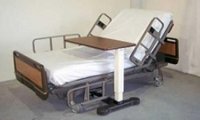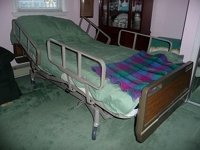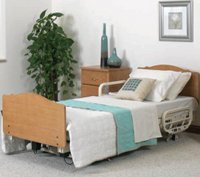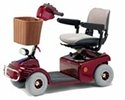
Hospital Adjustable Bed
Recommendations and A Buying Guide
A hospital adjustable bed can be beneficial for seniors as it allows them to raise/lower the head and foot of the bed.
Some models also raise/lower the whole bed which makes it easier to get in and out.
Hospital adjustable beds come in different types and brands.
There are the more mainstream beds that the foot and the head raise but there are no rails.
There are also the more "hospital" type adjustable beds that have two or four rails.
On some hospital beds, the foot and head electrical mechanism will only work together while on others they can be operated separately.
Hospital beds can be helpful for people with physical issues both for getting into and out of bed and for being easily adjusted when a position change is needed.
What is a Hospital Adjustable Bed?

Hospital adjustable beds can have the following options:
- Raise/lower head
- Raise/lower foot
- Raise/lower bed height
- Option of adding side or full bed rails
- Designed to accept a variety of mattress styles including pressure redistribution mattresses (ex. reduce risk for skin breakdown)
- Most models have both electric and manual options
- Most models have wheels making it easy to move the bed
- Most models can be taken apart to make it easy to transport and set-up
- Most models are single/twin size although there are also bariatric models
Fully electric beds allow the user to raise/lower head, foot and bed height.
Semi electric only allow the user to raise/lower the head/feet. Bed height can usually be adjusted manually.
Benefits

They are excellent for elderly who have the following issues:
1. Mobility Issues
Some elderly people have difficulty with transfers, ie. sitting to standing, sitting to laying down or getting up again.
Some seniors have issues with bed mobility, ie. rolling side to side, moving from lying down to sitting up.
A hospital adjustable bed can help with these issues as the height of the bed can be adjustable, the rails can provide something to hold onto when moving around in bed and getting up from a bed with the head of the bed up can make this transfer much easier.
2. Difficulty Sleeping while Lying Flat
Some elderly with Chronic Obstructive Pulmonary Disease (COPD) can only sleep comfortably with their head elevated.
There are other seniors that find this position more comfortable, such as those with back problems or other illnesses.
3. Spending Lots of Time in Bed
A hospital adjustable bed allows the elderly to change positions easily (head raised, feet raised, etc) with the switch of a button.
This also offloads pressure from on one part of the body to another, which is good for comfort and to prevent pressure sores.
4. Skin Issues
The elderly population is at high risk for bed/pressure sores as they are often frail, have thin skin and the incidence of chronic disease increases with age.
Diseases such as congestive heart failure, peripheral vascular disease or diabetes put seniors at high risk of bed/pressure sores.
Just being able to change position easily in bed is good for improving circulation and decreasing risk of bed sores. However, some seniors are at even higher risk.
Hospital adjustable beds can usually accommodate a variety of speciality pressure relief mattresses which reduce the risk of skin breakdown (ie. pressure/bed sores).
5. Easier Caregiver Support
Caregivers are in a better position to assist the client as they can raise the bed up to a better height for their backs when providing care (ie. not having to bend over to provide care such as assistance with rolling onto their side).
6. Keeping Seniors Safe in Bed
Seniors can be quite worried about falling out of bed. Some beds can have bed rails installed which can help keep clients in their bed.
Bed rails are also helpful for moving around in bed and getting up and down from bed.
Options to Consider When Purchasing
1. Type of Hospital Bed Needed
Does your elderly parent need a simple adjustable bed where the just the head of the bed and the foot of the bed move?
Or do they need a full hospital-style adjustable bed because:
- They need bed rails for getting up and down or moving around in bed.
- They need the option of the bed moving up and down in height (for caregivers, if they're worried about falling out of bed and want to be low to the ground at night, if they need a certain height that won't be provided in a regular adjustable bed - ie. to transfer to a wheelchair).
- They need to put a specialty mattress on top of the bed frame.
The typical adjustable beds you purchase at a sleep warehouse will have the mattress built in and will not accommodate bed rails.
2. Bed Rails
Are bed rails needed? If so, are 2 or 4 needed? Do you want full or "half" rails (span only half the length of the bed)?
Full rails are usually only good for people that are dependent on a caregiver as they cannot usually be operated independently. The caregiver usually has to put them up and down.
You can get 2 or 4 "half" rails (span only half the length of the bed). 2 half bed rails are great for helping with getting into and out of bed and moving around in bed. They can also be left up all the time as they generally don't get in the way.
4 half rails are also usually used only when people have caregivers to put them up and down for them.
For more information: Bed Rails for Elderly
3. Specialty Mattress
Does your elderly parent need a specialty mattress? Either to heal or prevent bed/pressure sores or for comfort?
If this is the case, you likely need to consider a hospital-style bed frame.
4. Manual or Electric Power Hospital Bed
Some hospital adjustable beds can be fully electrically powered, fully manual powered (usually crank style) or a combination of both.
If possible, the fully electric styles are the easiest to use.
5. Weight Capacity Needed
Check the weight capacity. Hospital adjustable beds come in regular and bariatric sizes.
6. Wheels
Are wheels needed? Usually wheels are helpful if the bed will need to be moved often or if there is a caregiver.
Having wheels for a caregiver is helpful so they can move the bed into the best position to provide care and prevent back issues.
7. Head and Foot Operator
Some head and foot operators only work as a unit (so if you want your head up, your foot automatically comes up and vice versa).
The most adjustability is usually the best to improve comfort so try to buy an adjustable bed where these options operate separately.
How Much Do They Cost?

They cost between $600 to $5000+. $600 for a basic model that is adjusted manually and $5000 for a fully electric bariatric model.
A full electric model should cost approximately $1000.
There are often used models available which are a good option. Just make sure all the features work (ie. raise/lower).
Accessories
There are a variety of accessories that can be used in conjunction with an adjustable hospital bed, including:
- Over bed table
- Trapeze (allows for user to reposition themselves in bed - if they have upper body strength)
- Half and full side rails
- Sheet/blanket supports (to keep blankets off lower legs and feet)
- Different mattresses (pressure redistribution, etc)
Return to Elderly Care Products
Return to Caring for Aging Parents






New! Comments
Have your say about what you just read! Leave me a comment in the box below.